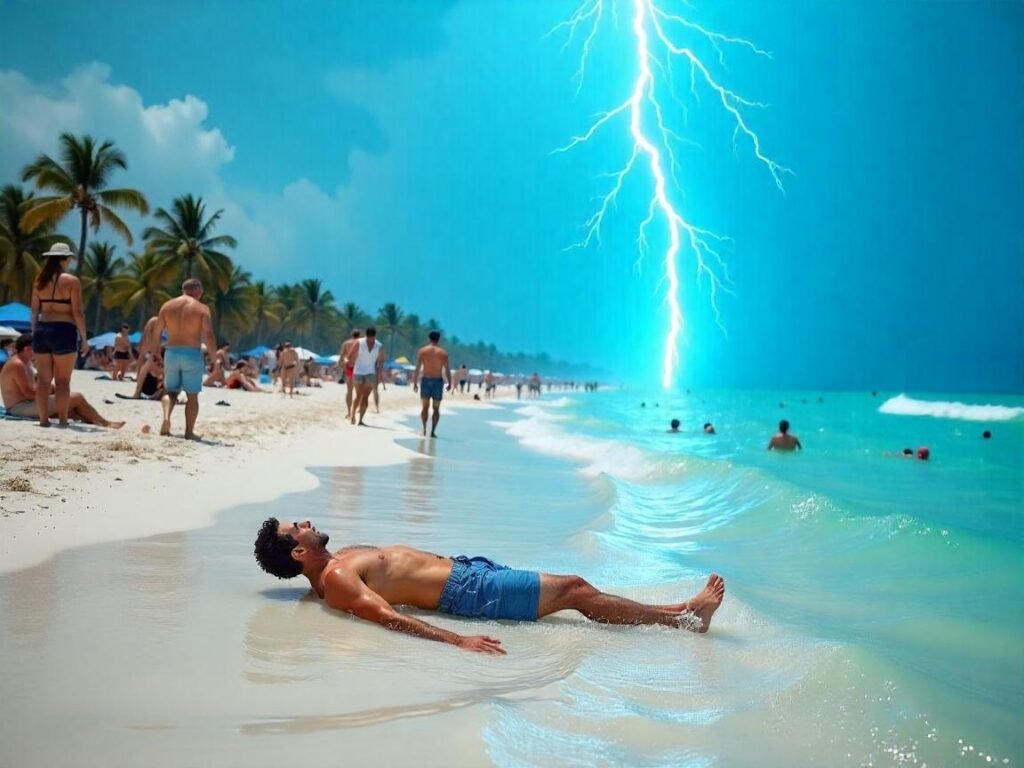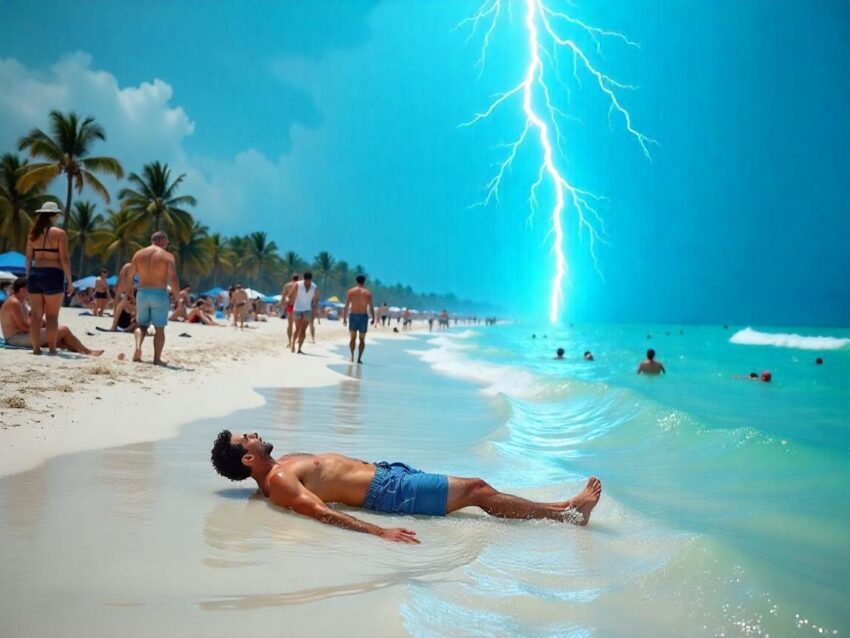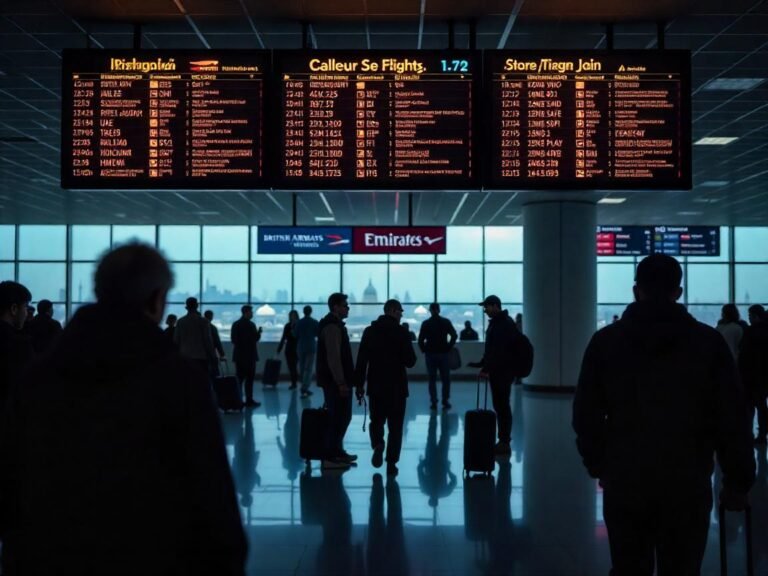
Monday, June 23, 2025

It was a perfect day. Clear skies. Warm sun. Tourists lounging at a Florida beach without a care. Then, without warning, a rare blue sky lightning strike split the air—stunning onlookers and shattering the peace. At first glance, there were no clouds, no signs of a storm. Yet, within seconds, terror replaced sunshine. Tourists screamed. One man collapsed. Others froze in disbelief. What had just happened under a blue sky? How could lightning strike from nowhere? As panic rippled across the Florida beach, confusion and fear took over. But this isn’t just a one-time event. These sudden bolts—known as “bolt from the blue”—are deadly, and they’re more common than you think. So, how can you save yourself from sudden thunder on what seems like a calm, sunny day? Keep reading. The truth behind this shocking weather phenomenon could save your life.
Tourists Stunned as Blue-Sky Lightning Strike Leaves One Critical at Florida Beach Hotspot
In a heart-stopping moment under seemingly perfect weather, a quiet afternoon at New Smyrna Beach, Florida, turned into a nightmare. A lightning strike — silent and sudden — bolted out of a clear blue sky and struck a young tourist standing in ankle-deep water.
This shocking incident unfolded on a sunny Friday just before 12:30 PM. The 29-year-old Colorado man was enjoying the warm Atlantic coast, unaware that a hidden threat loomed miles away. Moments later, he was unconscious in cardiac arrest, while beachgoers scrambled for help.
Meanwhile, two golfers at the nearby Venetian Bay Golf Course — a lush, luxury retreat in one of Florida’s most visited beach communities — were indirectly affected by the same storm cell. Although they escaped serious injury, the close call underscores a terrifying reality: lightning can strike even when the skies seem clear.
Florida’s Peak Travel Season Interrupted by Natural Shock
As Florida braces for the height of summer tourism, this rare meteorological phenomenon — known as a “blue-sky” lightning strike — has triggered renewed scrutiny around weather preparedness and public safety in outdoor recreation zones.
Blue-sky lightning, deceptively dangerous, originates from storms up to 20 miles away. These strikes often occur without warning, catching even seasoned travelers and residents completely off guard.
This tragedy comes at a time when Florida’s tourism is booming. New Smyrna Beach, located just south of Daytona Beach, is world-renowned for its 17 miles of pristine sand, vibrant surfing culture, and watersports scene. On any summer afternoon, the area hosts thousands of sun-seekers, surfers, and golfers alike.
But now, the beach is making headlines for all the wrong reasons.
The Travel Industry Reacts with Caution
Tourism operators, hotels, and airlines with stakes in Florida’s travel ecosystem are closely watching the ripple effects. Beachfront resorts in Volusia County are reevaluating emergency response protocols. Meanwhile, golf courses are reinforcing weather alert systems for guests.
Local authorities emphasize that lightning is the deadliest weather hazard in the state — surpassing hurricanes and flooding. Florida’s volatile coastal climate — fueled by high humidity, atmospheric instability, and sea breeze collisions — makes it the U.S. epicenter for lightning strikes.
As the so-called “Lightning Capital” of America, Florida experiences up to 300 lightning strikes per square mile annually. With over 90 thunderstorm days each year, the risk is ever-present — and growing more unpredictable due to climate change.
Critical Health Emergency Sparks Quick Response
In Friday’s incident, the victim collapsed after a powerful jolt intensified by the conductivity of shallow seawater. Bystanders immediately rushed to his aid, dragging him from the surf as a nurse on-site began chest compressions.
Paramedics soon arrived, reviving his pulse before rushing him to a nearby hospital. As of the latest reports, his condition remains critical.
Officials from Volusia County Beach Safety and the New Smyrna Beach Fire Department praised the swift community response. But experts say this type of lightning strike — invisible, silent, and deadly — leaves virtually no time to react.
New York’s Central Park Also Rocked by Sudden Strike
Just one week earlier, lightning struck another victim under eerily similar circumstances — this time in New York City’s Central Park. A 15-year-old boy was burned on the neck after sheltering beneath a tree during an abrupt summer storm. The charge traveled from the tree into a chain around his neck, sending him to the hospital in stable condition.
The parallel incidents, hundreds of miles apart, are stoking fears that weather unpredictability is intensifying in high-tourism zones nationwide.
Travel Experts Call for New Weather Safety Measures
As lightning incidents make headlines from Florida to New York, stakeholders across the travel sector are calling for heightened safety protocols.
Hotels, especially those along beachfront corridors, are being urged to deploy AI-powered weather alert systems to notify guests in real-time. Golf courses are exploring the installation of early-warning lightning detectors and lightning-safe shelters.
Meanwhile, travel insurance providers are reassessing policy language to better account for natural hazard-related injuries in outdoor recreational areas.
At airports across Florida, the aviation sector is also on alert. Lightning is a known hazard for ground crews, prompting recent FAA-mandated delays during high-risk storms. Experts say if these strikes continue, summer flight schedules could see further weather-related disruptions.
Emotional Fallout and Public Sentiment Surge Online
Social media platforms lit up with reactions following the Florida strike. Posts tagged #NewSmyrnaBeach and #LightningStrike surged as users expressed concern and shared safety tips. Many travelers admitted they had never heard of blue-sky lightning until now.
Emotional support also poured in for the victim, with travel influencers urging followers to remain vigilant even on sunny days.
More troubling, however, are rising fears among families planning summer beach vacations to Florida. Some have already contacted tour agencies asking about cancellation policies and storm contingency plans.
What This Means for the Travel Industry Moving Forward
Tourism authorities are now under pressure to launch public awareness campaigns — not just during stormy days, but every day during Florida’s high-risk season.
Emergency drills, bilingual beach signage, lightning education pamphlets in hotel rooms, and app-based alert systems could soon become standard in top tourist destinations.
The broader travel industry, from airline safety boards to outdoor recreation companies, must now factor blue-sky lightning events into their risk models.
This incident in New Smyrna Beach isn’t just an isolated weather anomaly — it’s a wake-up call for an entire industry built around outdoor leisure.
How You Can Save Yourself From Sudden Thunder: Essential Travel Safety Tips for Lightning Season
You’re standing on a sun-kissed beach, waves gently brushing your feet, not a single cloud in sight. The sky is brilliantly blue, the breeze warm, and the moment feels perfect. But within seconds, paradise can turn into panic — all from a bolt you never saw coming.
Welcome to the world of sudden thunder, a weather phenomenon that’s not just rare, but deadly. And as terrifying as it sounds, it’s becoming increasingly common in popular travel hotspots like Florida, the so-called Lightning Capital of the U.S.
So, how can you protect yourself? What do you do when there’s no rain, no storm, and no warning — just one devastating flash?
Let’s break it down.
The Deadly Truth About Blue-Sky Lightning
Blue-sky lightning — also called a “bolt from the blue” — is a freak occurrence where a lightning bolt travels from a storm up to 20 miles away, striking under clear skies. You don’t see the storm. You don’t hear the thunder. But suddenly, lightning hits — fast and fierce.
That’s exactly what happened recently at New Smyrna Beach in Florida. A 29-year-old tourist, standing in shallow water on a bright and beautiful day, was struck without warning. He collapsed instantly, leaving horrified beachgoers scrambling to save his life. And while he survived thanks to quick-thinking bystanders, the emotional impact shook everyone there — and it’s making travelers everywhere rethink their beach safety routines.
Why Travelers Are at Risk
Whether you’re hitting a Florida beach, a Caribbean golf course, or a mountain trail in the Rockies, you’re likely spending a lot of time outdoors — and that increases your risk.
Lightning doesn’t just strike during dark, stormy skies. It can come out of nowhere and travel sideways for miles, catching people completely off guard. In fact, blue-sky lightning accounts for a surprising number of injuries and fatalities each year, particularly among hikers, swimmers, and golfers.
Tourists, often unfamiliar with local weather patterns, are especially vulnerable. Many assume that if it’s sunny, it’s safe. But in lightning-prone regions like Florida, that couldn’t be further from the truth.
What You Can Do to Stay Safe
The good news? You can protect yourself from sudden thunder — but it requires a change in mindset and a few critical habits.
1. Track the Weather — Beyond What You See
Before heading out, check the local weather radar, not just the forecast. Apps like MyRadar, AccuWeather, or NOAA Weather Radar Live can show nearby storm activity, even if the sky above you looks clear. Look for lightning alerts — many apps now include real-time strike tracking.
2. Respect the 30-30 Rule
If you do hear thunder, even once, count the seconds until you hear it after a lightning flash. If it’s 30 seconds or less, the storm is close enough to strike you. Stop what you’re doing and seek shelter immediately.
Wait at least 30 minutes after the last rumble before resuming outdoor activity.
3. Avoid Water and Open Spaces
Water is a strong conductor of electricity. Being in the ocean, a pool, lake, or even standing in wet sand or ankle-deep surf can be dangerous. Likewise, open spaces like golf courses, beaches, and hiking trails offer lightning a clear path — and that path could be you.
When in doubt, get out.
4. Know Where to Shelter
The best place to be during a thunderstorm is indoors — preferably inside a building with plumbing and electrical wiring, which channels lightning safely into the ground. If that’s not an option, a fully enclosed metal vehicle can also provide protection.
Avoid picnic shelters, tents, umbrellas, or trees. These offer zero safety and can actually increase your risk.
5. Educate Your Travel Group
Make sure everyone in your group — kids, friends, or elderly parents — knows the signs of approaching weather and where to go in an emergency. When traveling, time can mean everything, so pre-planned responses matter.
The Emotional Toll of Being Caught Off Guard
What’s most haunting about sudden thunder is the sheer shock. People expect danger to come with warnings: dark clouds, rain, wind. But blue-sky lightning defies all those cues.
That’s why it leaves such a lasting emotional mark. The fear. The guilt. The helplessness.
For tourists who survive a strike — or witness one — the trauma can linger long after the vacation ends. That’s why mental health support is just as critical as physical recovery in these rare incidents.
Why the Travel Industry Must Do More
Hotels, golf resorts, and beachside rental companies have a responsibility to educate guests about lightning safety. As travel demand rises and outdoor tourism thrives, weather awareness should be built into welcome packets, in-room guides, and even digital check-ins.
Airports, too, are stepping up. Ground crew operations now include mandatory lightning shutdowns when strikes are detected nearby, but passengers need to be looped in — especially during summer travel when delays are frequent.
Tour operators can no longer assume guests will “just know” what to do. Safety is a shared responsibility.
A Final Word for Travelers
The beach may look calm. The skies may be crystal clear. But sudden thunder doesn’t follow the rules.
Next time you’re out soaking up the sun, remember this: nature doesn’t care about your plans, and it rarely sends warnings.
Stay aware. Stay connected. And never underestimate what can happen in a flash.
Because the only thing more surprising than blue-sky lightning — is not being ready for it.
Final Thoughts
The summer of 2025 has taken a sharp, sobering turn. As blue-sky lightning redefines the boundaries of traveler risk, destinations must evolve. The promise of paradise is no longer enough — tourists demand safety, predictability, and proactive leadership.
What happened in Florida wasn’t just weather. It was a warning.







